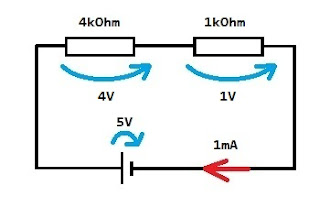so, this one and the next post will be the last elecrticity posts for a while. I have to overthink the decission to post something like that.
The deeper i go into the subject, the more basic information is needed and i dont think a new follower will read through all of that just to understand what im talking about.
Maybe I'll do more projects but wont explain them completely. Just the blueprint, what you need and what it does.
And of course, way more game reviews. Maybe some music, too. Or i should make something like a walthrough for some games....
But i dont want to let my blog look like i have no real theme in it. Or I just stop with those long posts and tell you something in 2-3 sentences about... dunno, something.
Argh, dessicions, dessicions.
Well, i'll decide... later.
For now, i'll tell you about "parallel" and "in series" (im not sure if its called "in series". Google translate sucks. If someone knows that, please tell me).
Lets talk about "in series":
Q:
When are two components "in series"?
A:
Well, thats really simple. When the components come after each other so the current can only flow through one at a time.
Q:
How are current and voltage acting on components that are "in series"?
A:
The current in the circuit is the same at all points. The current will never split. Where else should it flow than straight the way it has to?
The supply voltage splits itself onto all components. We remember: On the biggest resistance stands the biggest voltage. Thats why there is always voltage onto your power socket. The resistance between the 2 holes of the power socket is (almost) infinitely.

red = current
blue = voltage
The higher the resistance, the less the current. => Infinite resistance = no current but the whole voltage onto the resistor.
Next time, we'll talk about "parallel"
Bye :D



Great explanation! Very clear and concise, "in series" is indeed the correct term
AntwortenLöschenNice description dude!
AntwortenLöschenI remember learning about that at school, I remember doing some fun things with electricity there. It's a shame I can't remember if it is "in series" but I think it is.
AntwortenLöschenInteresting stuff. I'm a little confused though.
AntwortenLöschenI was taught this in my senior year of high school. Didn't retain any of the knowledge, though.
AntwortenLöschennice review i love electronics
AntwortenLöschenThis will help me next year in my electrics course! Thanks.
AntwortenLöschenGreat explanation!
AntwortenLöschenInteresting, this will come in handy for me thanks!
AntwortenLöschenI wish I understood this stuff better but it kinda made a little bit of sense...kinda.
AntwortenLöschengreat information thanks for helping us understand!
AntwortenLöschenreally interesting, thanks for the info! :)
AntwortenLöschencan't wiat for the parallel talk
AntwortenLöschenIm starting to understand a bit, but not so much hahaha
AntwortenLöschenGood for those who are learning :)
AntwortenLöschenI call it in series, but yeah google translate does have a lot of faults. This was a good read, I might have to print out your blog just to have all this info handy
AntwortenLöschenThis would of helped me on my ASVAB!
AntwortenLöschenI usually see "in series' reffered to as "serial". Looking forward to the next post, some soldering tips for noobs would be appreciated too.
AntwortenLöschennice post to refresh my physics knowledge :D
AntwortenLöschenHave a friend into this, always talking about it.
AntwortenLöschenThis is interesting stuff
AntwortenLöschenI always wanted to get into electronics, thanks!
AntwortenLöschenKeep it going!
AntwortenLöschen